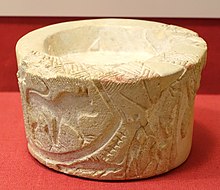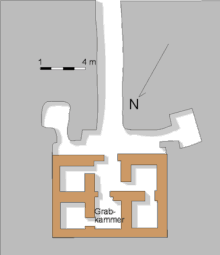Qustul
Map of Egypt |
Qustul is an excavation site in Lower Nubia , north of the 2nd cataract in Egypt and directly on the border with Sudan . The site was on the eastern side of the Nile and, like most historical sites, was flooded by Lake Nasser between the first two cataracts in the early 1970s after the construction of the Aswan Dam . In Qustul, a burial ground belonging to the X group from AD 350–600 was discovered in the 1930s, and group A graves from around 3800-3100 BC in the early 1960s . Discovered.
A group
Qustul was the settlement center of the A group. From 1962, the Chicago Oriental Institute under the direction of Keith C. Seele unearthed 33 graves in the area of "Cemetery L", including 12 graves which, because of their size and graves, are considered royal graves and compared with the necropolis of the predynastic Hierakonpolis . None of the rulers is known by name. The graves were already heavily looted in ancient times. Pottery from local production has been preserved, including large numbers of egg-shaped vessels with geometric patterns. The fact that these vessels practically did not appear in normal graves suggests their special importance and exclusive use. In addition, imported clay pots decorated with hieroglyphics , jewelry and cult objects were found. A censer with what is probably the earliest representation of a king in the Nile Valley attracted attention. It is a stone bowl with a cylindrical rim into which figures have been cut. The culture of Group A was different from the cultures of Ancient Egypt ; their decline or retreat to a nomadic way of life was probably caused by the consolidation of power of the 1st dynasty . In 1968 the excavations had to be finished.
X group or Ballana culture
61 tombs were found that were excavated in 1931 as part of the Oxford Expedition to Nubia 1929-1934 under the direction of Walter Bryan Emery and his assistant Laurence Kirwan. These are large barrows (tumuli) , in which there were often various chambers, to which a passage led down.
Some of these imposing tombs were well preserved, some had not been plundered and contained rich gifts. They belonged to local kings, princes and other aristocrats. The largest grave found was given the number Q 3 . The royal tomb consisted of eight chambers, it is the only tomb with a chamber made of fired bricks. The actual burial chamber was looted, but numerous additions were found in the side chambers and in the hill itself, including several horses with rich bridles . The objects found represent a mixture of Meroitic-Egyptian, Coptic and late Roman- Byzantine handicrafts. Silver medallions, which were part of the horse's bridle, are decorated with lions, for example. A large board game called Tabula lusoria , which was inlaid with ebony and ivory , was made locally and resembles Meroitic objects. The game was widespread and was especially valued in Rome . It is believed that Qustul was the early burial place of the kings of Nobatia .
The graves date back to the time after the fall of the Meroitic Empire and before Nobatia was established as the northernmost of the three Christian Nubian kingdoms. They basically fall into the period between 400 and 600 AD. Laurence Kirwan narrowed the period to the end of the 4th to the end of the 5th century and, in contrast to Bruce G. Trigger and William Yewdale Adams, considered the graves of Qustul to be older than the Ballana cemetery on the western side of the Nile . The grave Q 14 contained a bronze coin of the Roman Emperor Valens (r. 364–378), which is valuable for dating . The early dating around 370, i.e. shortly after the Meroitic period, is supported by finds of spearheads with Meroitic characters . Grave Q 3 contained silver luxury goods imported from Egypt that had been manufactured in the 370s.
László Török created an experimental chronology from the grave finds and comparisons of the shapes of the graves of Qustul and Ballana, according to which the youngest graves in Qustul, the royal grave Q 2 and the aristocratic grave Q 48 , were built in the fifth generation around 410. Without there having been a cultural break, the following generations of kings six to twelve were buried in Ballana from the 420s onwards. The last burials there took place shortly before 500 AD.
literature
- Rachael Jane Dann: Aesthetics and identity at Qustul and Ballana, Lower Nubia. Durham theses, Durham University 2006.
- Walter Bryan Emery : Nubian treasure, an account of the discoveries at Ballana and Qustul. Methuen, London 1948, pp. 44-56.
- Bruce B. Williams: Excavations Between Abu Simbel and Sudan: The A-Group Royal Cemetery at Qustul. Cemetery L (Nubian Expedition). Oriental Institute of the University of Chicago, 1986. Book Excerpts: Bruce Beyer Williams: The A-Group Royal Cemetery at Qustul, Cemetery L. .
Web links
- K. From Unity to Fragmentation: The Post-Meroitic Period. 300-600 AD. Nubianet, Education Development Center (to the X Group)
- C. The Emergence of the State: The A-Group and Pre-Kerma Periods: 3500-2500 BC 1. Lower Nubia's Mystery People: The "A-Group". Nubianet, Education Development Center (to A group)
- Boyce Renseberger: Clues to Oldest Monarchy Found in Nubia. New York Times, March 1, 1979
Individual evidence
- ^ László Török: The Chronology of the Qustul and Ballana Cemetaries. In: Martin Krause (Ed.): Nubian Studies. Conference files of the 5th International Conference of the International Society for Nubian Studies Heidelberg, 22. – 25. September 1982. von Zabern, Mainz 1986, pp. 191–197.
Coordinates: 22 ° 14 ′ 0 ″ N , 31 ° 37 ′ 0 ″ E


